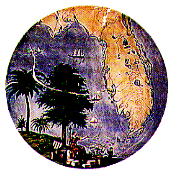Statehood
Florida became the twenty-seventh state in the United States on March 3, 1845. William D. Moseley was elected the new state's first governor, and David Levy Yulee, one of Florida's leading proponents for statehood, became a U.S. Senator. By 1850 the population had grown to 87,445, including about 39,000 African American slaves and 1,000 free blacks.
The slavery issue began to dominate the affairs of the new state. Most Florida voters—who were white males, ages twenty-one years or older—did not oppose slavery. However, they were concerned about the growing feeling against it in the North, and during the 1850s they viewed the new anti-slavery Republican party with suspicion. In the 1860 presidential election, no Floridians voted for Abraham Lincoln, although this Illinois Republican won at the national level. Shortly after his election, a special convention drew up an ordinance that allowed Florida to secede from the Union on January 10, 1861. Within several weeks, Florida joined other southern states to form the Confederate States of America.
